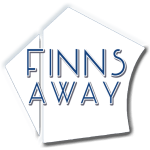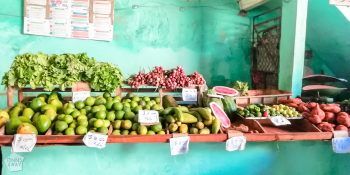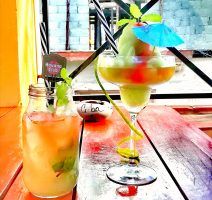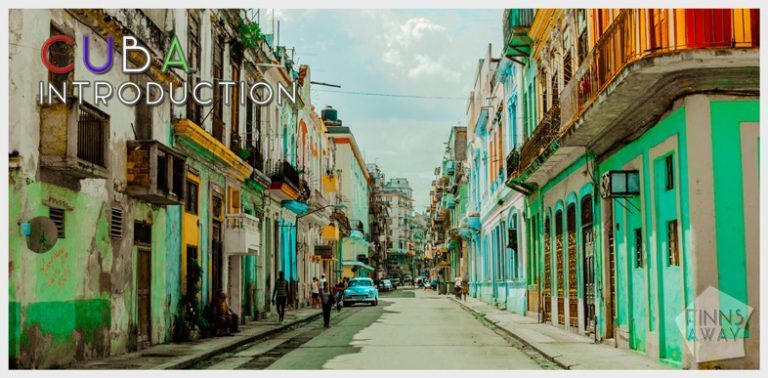
CUBA - Colorful, Unique, Beautiful, Authentic
In October we begun our adventure in Latin America by flying from Europe to Cuba. It was a new country for us, and this actually was also our first time in the Caribbean Islands overall. Many tourists come to Cuba for an all-inclusive resort holiday, but for independent travelers Cuba is a something different. In this post we sum up our experiences and thoughts of traveling in Cuba, and inform how Cuba is as a travel destination during off-season.
Table of Contents
- Confusing, but charming travel destination
- Cuba in October
- Accommodation in Cuba
- Eating and drinking in Cuba
- Internet in Cuba
Confusing, but charming travel destination
Before flying to Cuba, we were a bit suspicious. Communist regime, strictly regulated society and limited availability of even the basic necessities due to the embargo, that has lasted for decades. Doesn’t sound too appealing, does it? In addition, we knew that there was an oil crisis ongoing, meaning power outbreaks in some parts of the country and limited availability of fuel available for transportation trucks and even for private cars. On the other hand, we were very excited to experience this exceptional country, and to see with our own eyes how the society works.
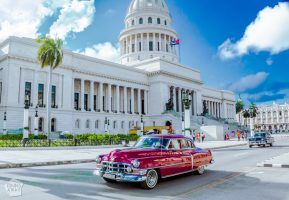 And yes, we ended up loving Cuba. Despite the political and social problems, it’s a wonderful country to travel in, very safe for tourists and affordable. We only had time to explore the western part of the island, and in there alone, we could experience the greenest nature, beautiful beaches, rural countryside and of course the busy streets of Havana. The colors of Cuba are amazing, and the local people are mostly very welcoming and friendly. Vacation in one of the beach holiday resorts in Varadero is probably a great experience also, but we warmly recommend traveling around and getting to know the local way of living.
And yes, we ended up loving Cuba. Despite the political and social problems, it’s a wonderful country to travel in, very safe for tourists and affordable. We only had time to explore the western part of the island, and in there alone, we could experience the greenest nature, beautiful beaches, rural countryside and of course the busy streets of Havana. The colors of Cuba are amazing, and the local people are mostly very welcoming and friendly. Vacation in one of the beach holiday resorts in Varadero is probably a great experience also, but we warmly recommend traveling around and getting to know the local way of living.
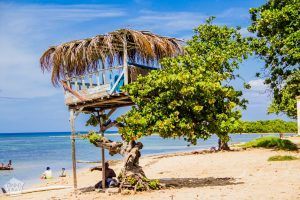 How is Cuba so exceptional for travelers then? Well, it’s about the combination of the things you see, feel and experience, like in any other destination of course. But traveling in Cuba is kind of like a jump back in time. The magic lives in the old-fashioned feel, the vibrant colors and the laid-back atmosphere. It’s in the “lets fix it” attitude of the locals, their imagination to find a solution without having proper spare parts or tools available. In Cuba, you will see huge amount of old, classic American cars still in daily use, together with Ladas and Moskvitches. You can also see people commuting in a tractor trailer and oxcarts slowly riding on the side of a motorway. You can watch the sunset along famous Malecon Ocean Drive, maybe sipping tasty Cuban rum and smoking a Cuban cigar, that you bought with just pennies from a tiny street-side store.
How is Cuba so exceptional for travelers then? Well, it’s about the combination of the things you see, feel and experience, like in any other destination of course. But traveling in Cuba is kind of like a jump back in time. The magic lives in the old-fashioned feel, the vibrant colors and the laid-back atmosphere. It’s in the “lets fix it” attitude of the locals, their imagination to find a solution without having proper spare parts or tools available. In Cuba, you will see huge amount of old, classic American cars still in daily use, together with Ladas and Moskvitches. You can also see people commuting in a tractor trailer and oxcarts slowly riding on the side of a motorway. You can watch the sunset along famous Malecon Ocean Drive, maybe sipping tasty Cuban rum and smoking a Cuban cigar, that you bought with just pennies from a tiny street-side store.
Cuba is also complicated, and definitely not the easiest destination to travel around (more about the public transportation in a separate post soon). Also, if you don’t speak Spanish, you won’t have a common language with majority of the people. You might not like the food, and you may feel that all you can buy from the shops are lemonade and rum. You might get frustrated with the internet connections, that are often either weak or expensive. You may feel kind of lost for the first few days, before starting to understand the country. But still, I bet Cuba will charm you as well.
Cuba in October
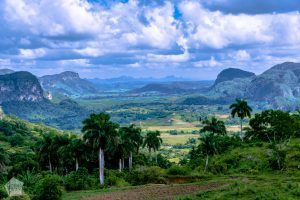 October is still considered as part of the rainy season, and there is still a possibility of hurricanes as well, since the hurricane season lasts from June to November. However, during our two weeks stay the weather was mostly perfectly sunny, though very humid, and being outside meant being sweaty most of the time. We didn’t let that bother us too much, but when walking around (or especially when doing sports), it’s important to stay hydrated, and to use sunscreen. The rainy season in Cuba doesn’t mean constant rain, more like short showers and sometimes more cloudy days. It’s not often windy either, but of course if there are tropical storms hitting the island or passing by close, the situation is then different.
October is still considered as part of the rainy season, and there is still a possibility of hurricanes as well, since the hurricane season lasts from June to November. However, during our two weeks stay the weather was mostly perfectly sunny, though very humid, and being outside meant being sweaty most of the time. We didn’t let that bother us too much, but when walking around (or especially when doing sports), it’s important to stay hydrated, and to use sunscreen. The rainy season in Cuba doesn’t mean constant rain, more like short showers and sometimes more cloudy days. It’s not often windy either, but of course if there are tropical storms hitting the island or passing by close, the situation is then different.
Traveling during off-season means less tourists and lower prices. Especially the accommodation prices seem to drop during the quieter months, and it’s easy to find private rooms in guesthouses, or actually they are rooms in private homes, with just around 10 euros per night. During the peak season, which is in winter and also during the mid-summer, the prices of most of the rooms climb up to over 20 euros per night.
Related post: Cost summary of two weeks in Cuba
Accommodation in Cuba
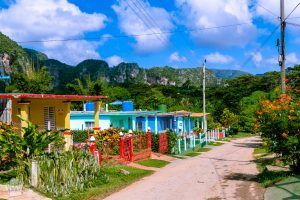 Hotels and hostels are not very common in Cuba, if not taking into account the resort hotels in beach destinations or the luxurious big hotels of Havana. Budget hotel with dorm beds and simple double rooms is almost nonexistent concept in the country. For backpackers and other independent travelers, the most common way is to book a room in private homes, called casas particulares. These rooms usually have a private bathroom and sometimes a private entrance also, and they all come with A/C. Often there is also a refrigerator or even a small kitchenette, a television and sometimes even WiFi.
Hotels and hostels are not very common in Cuba, if not taking into account the resort hotels in beach destinations or the luxurious big hotels of Havana. Budget hotel with dorm beds and simple double rooms is almost nonexistent concept in the country. For backpackers and other independent travelers, the most common way is to book a room in private homes, called casas particulares. These rooms usually have a private bathroom and sometimes a private entrance also, and they all come with A/C. Often there is also a refrigerator or even a small kitchenette, a television and sometimes even WiFi.
All casas that we stayed in were super clean, spacious and nicely decorated. In fact, for a house owner to get the license to rent the rooms, they need to fulfill certain criteria, so basically that means that you won’t find poor quality rooms in Cuba, or at least not in the official casas particulares. Official casas have a sign with a blue anchor-like symbol, and all guests, and their passport details, have to be listed in a guestbook and reported to the government.
As there are a lot of casas particulares everywhere around Cuba, it’s not necessary to book ahead, unless you have some particular place in mind. Wherever you go, there will be someone asking weather you have accommodation already, and recommending a casa of a friend or a relative for you. If you want to book ahead, you’ll find a lot of casas in AirBnB (register via the link and get a discount of your first stay) and in booking.com. Even if you don’t want to book anything in advance, you should check the price level of the casas in your destination before you go, as this will help you to negotiate a fair price with the casa owners.
Eating and drinking in Cuba
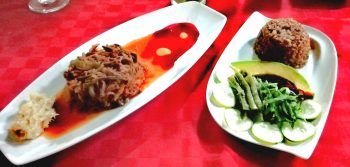 In this chapter some general information about food and drinks in Cuba. To start with, we have to say that the basic Cuban food served in local restaurants and casas tends to be a bit boring. Cubans don’t seem to use a lot of neither spices nor imagination in their everyday food. The ingredients are good though, like fresh fish and other seafood, with local vegetables and fruits, when available. A standard meal means the meat of your choice (pork, chicken, fish, seafood, beef) served with rice and beans, some kind of a side salad, which often includes simply just green beans and cucumber, fried cooking banana and yams. Lack of ingredients can mean that there aren’t a lot of possibilities to make a great variety of dishes. On the other hand, in fishing villages you can get a big portion of fresh lobster to your plate with just a couple of euros. The Cuban national dish is called Ropa Vieja; shredded beef (or pulled pork) fried with onions, garlic, bell peppers and tomatoes.
In this chapter some general information about food and drinks in Cuba. To start with, we have to say that the basic Cuban food served in local restaurants and casas tends to be a bit boring. Cubans don’t seem to use a lot of neither spices nor imagination in their everyday food. The ingredients are good though, like fresh fish and other seafood, with local vegetables and fruits, when available. A standard meal means the meat of your choice (pork, chicken, fish, seafood, beef) served with rice and beans, some kind of a side salad, which often includes simply just green beans and cucumber, fried cooking banana and yams. Lack of ingredients can mean that there aren’t a lot of possibilities to make a great variety of dishes. On the other hand, in fishing villages you can get a big portion of fresh lobster to your plate with just a couple of euros. The Cuban national dish is called Ropa Vieja; shredded beef (or pulled pork) fried with onions, garlic, bell peppers and tomatoes.
Cuban restaurants have a reputation of serving not-that-delicious meals, but the restaurant scene is quickly changing. In the past, all the restaurants were state-owned, but nowadays it’s possible for Cubans to run their own restaurant businesses. This has led to opening a bunch of new restaurants with ambitious menus, and especially in Havana it’s possible to find wide range of restaurants, also serving delicious international cuisine. Cuban street food scene is not very wide, but there is always a small fast food stall somewhere near you. The most popular dish seems to be pizza (small pizza, often with no other fillings than cheese, cost 10 to 15 CUP, so around 0,50 €), and often there are also sandwiches, hamburgers and omelets available.
For making your own food, Cuba can be a challenge. You can usually buy delicious fruits and vegetables from the agro markets, but the assortment of the grocery stores is very limited. Also, all the imported goods are very expensive to buy. When it comes to drinks, it can be surprisingly hard to find bottled water, at least in big bottles. In our case, the fuel crisis might have had some effect to that though, but we sometimes checked ten stores before finding one with water available. One advice, stock it when you find it. Another option is to bring a water filter with you. We ended up using our filter, that is mostly meant for outdoor purposes, to filter the tap water, and didn’t have any stomach issues.
Regarding alcohol drinks, the must-have in Cuba is of course rum. Cuban rum is delicious, and it’s pretty cheap and available everywhere. There are of course a lot of different varieties of rum, Havana Club being probably the most popular brand among tourists at least. Beer in Cuba is mostly light lager, usually easily available but a bit pricey; small cans of local beer cost around 1,5 € and imported around 2 to 2,5 €. There is not much variation in the prices between supermarkets and restaurants. Cubans usually drink their rum neat, but restaurants and bars often offer a long list of rum-based cocktails, and during happy hours you can get delicious mojito and other Cuban rum drinks with around 1,5 euros.
Internet in Cuba
Networks in Cuba are developing quickly, but internet connections are still today somewhat limited, and monitored by the government. Using data is also quite expensive. There are public WiFi hotspots for example in many parks and hotels around the country, and also tourists can use them after buying a pre-paid internet card called Nauta from ETECSA, and registering with a password that is in the card. ETECSA is a state owned company that provides telephone and internet connections around the country. The price for using WiFi with ETECSA card is 1 CUC (0,9 €) per hour, so not that expensive, but the connection can be slow due to the amount of users. Read more about internet and connectivity in Cuba from ETECSA homepage (in Spanish).
Another, more expensive option is to by a Cuban SIM card with a data package, but the price of the SIM card itself is high, and the data is not cheap either. In general, using foreign SIM cards for data roaming is very expensive, so be sure to check the rates with your operator if you plan to use your data package. Nowadays it’s also possible to find free WiFi at least in touristic destinations, as many restaurants and part of the casas offer WiFi for their customers and guests. We decided not to use internet at all during our stay, as it was also a holiday for us, and we wanted to take a break of being constantly online. Two weeks without internet made us realize, how much time we actually spend in social media and otherwise surfing, in addition to being online when we work. I guess it’s recommendable for everyone to sometimes take some time without having your phone in hand.
More about traveling in Cuba:
Postcards from Havana
Hiking in beautiful Viñales
Local transportation in Cuba
